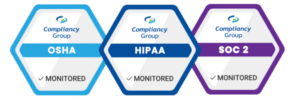As many states move into Phase II of reopening, the Centers for Medicare & Medicaid Services (CMS) has released new guidance for non-emergency care. The CMS guidance provides insight for healthcare facilities wishing to offer non-emergency care, as well as for patients seeking non-emergency care.
Do you have an effective HIPAA compliance program?
Find out now by completing the HIPAA compliance checklist.
CMS Guidance: Reopening Non-emergency Healthcare Facilities
Healthcare facilities wishing to reopen for non-emergency care must consider the following CMS guidance and CMS recommendations:
Facility Considerations: when reopening healthcare facilities, providers must ensure that there are proper precautions in place to keep non-COVID-19 (NCC) patients and COVID-19 patients separated.
CMS guidance recommends the following in regards to facility precautions:
◈ Providers should have separate entrances, waiting rooms, and exits for NCC and COVID-19 patients.
◈ Social distancing should ensure minimal contact between NCC and COVID-19 patients.
◈ Facilities should keep low patient volumes.
◈ Non-patient visitors should be kept to a minimum. All visitors should be assessed for COVID-19 symptoms prior to entering the facility. If a visitor shows COVID-19 symptoms the visitor should be prohibited from entering the facility.
COVID-19 Testing: patients receiving non-emergency care should be tested for COVID-19 prior to their visit.
CMS guidance recommends the following protocols for patient testing:
◈ 24 hours before a hospital stay or procedure, non-emergency patients should receive COVID-19 testing. If testing is not possible, patients should self-quarantine for 14 days before a procedure.
◈ Before accepting COVID-19 positive patients for non-emergency care, providers should consider the risks versus the benefits of treatment.
◈ All staff working in the NCC care unit should be assessed daily for COVID-19.
◈ Non-patient visitors who present COVID-19 symptoms should not be allowed to enter the facility. They should be informed that they should self-quarantine and their healthcare provider should be contacted.
◈ Public health authorities should be informed of test results in accordance with state requirements.
PPE and Supplies: CDC guidelines for the use of protective gear should be upheld.
Additionally CMS guidance recommends the following:
◈ Providers should wear surgical masks at all times unless the services they provide require use of a N95 respirator.
◈ Procedures on the mucous membranes, including the respiratory tract, with a higher risk of aerosol transmission, should be done with great caution, and staff should utilize appropriate respiratory protection such as N95 respirators and face shields. If N95 respirators are needed, they must be used in compliance with protocols that meet provisions of related OSHA standards.
◈ Patients and visitors should wear cloth face masks at all times. If patients or visitors do not have masks, the facility should make masks available.
◈ Providers should take efforts to preserve PPE, including following guidelines for sanitization and reuse.
Workforce: there must be sufficient staff to treat COVID-19 patients as well as non-emergency patients.
CMS guidance recommends the following:
◈ Facilities should have enough staff available to augment COVID-19 related services as needed, and staffing levels in the community must remain adequate to cover a potential surge in COVID-19 cases.
◈ Facilities should screen personnel in accordance with CDC guidelines.
◈ Personnel should be screened for COVID-19 on a daily basis. Symptomatic staff should be tested for COVID-19, prohibited from entering the healthcare facility and follow quarantine protocols.
◈ Staff working in NCC areas should not rotate into COVID-19 care areas unless absolutely necessary.
◈ Any staff diagnosed with, or suspected of having, COVID-19 should follow the CDC guidance on returning to work.
Sanitation: proper sanitation protocols must be followed to prevent cross-contamination.
CMS guidance recommends the following:
◈ Maintain an established plan for thorough cleaning and disinfecting prior to using spaces for NCC services.
◈ Ensure that equipment used for patients diagnosed positive for COVID-19 are thoroughly decontaminated per CDC recommendations.
◈ For management of higher risk patients, the CDC recommends that clinicians take these precautions:
◆ Develop a care plan with each patient and patient-specific plans for how to receive unscheduled, urgent care if the need arises, including how to contact the provider 24/7.
◆ If possible, provide care remotely (i.e., by telemedicine).
◆ Limit major surgical procedures as much as clinically possible.
◆ When in-person care is necessary, arrange for patients to minimize exposure through practices such as:
◈ limiting entrances with screening protocols;
◈ avoiding waiting areas with other patients;
◈ waiting in the car until the visit starts;
◈ maintaining social distancing;
◈ wearing a face mask; and
◈ Providers entering areas where at-risk populations are should practice social distancing and follow appropriate CDC guidelines to minimize the risk of infection.
CMS Guidance: Non-emergency for Patients
In addition to providing guidance for providers treating non-emergency patients, CMS guidance extends to patients seeking non-emergency care.
CMS guidance recommends the following:
◈ Do not postpone necessary preventative care or assessment of ongoing health issues.
◈ Talk with healthcare providers regarding steps to minimize transmission of COVID-19, as well as any particular health conditions that may make someone at higher risk.
◈ Consider “virtual” or “telehealth” services where appropriate.
◈ Discuss with healthcare providers whether to be tested for COVID-19 prior to an in-person visit.
◈ During an in-person appointment:
◆ Wear a face mask;
◆ Limit the number or people who come to the appointment;
◆ Avoid crowded waiting rooms and implement social distancing;
◆ Wash hands and use sanitizer frequently; and
◆ Participate in all facility health screening.
◈ High-risk and vulnerable populations should, to the extent possible, stay home, avoid crowds, and self-isolate. If such persons need to be in public, they should practice social distancing by staying a minimum of six feet away from others.






